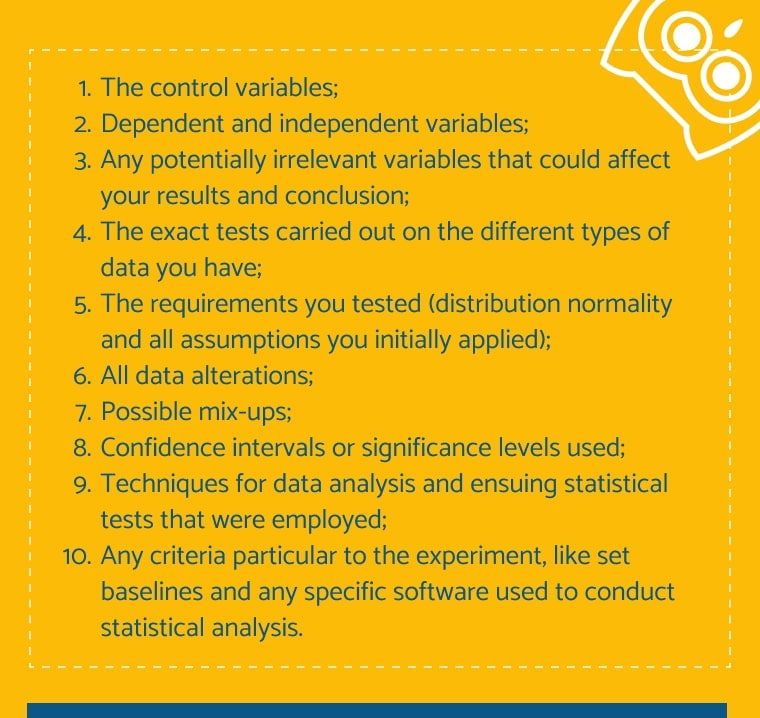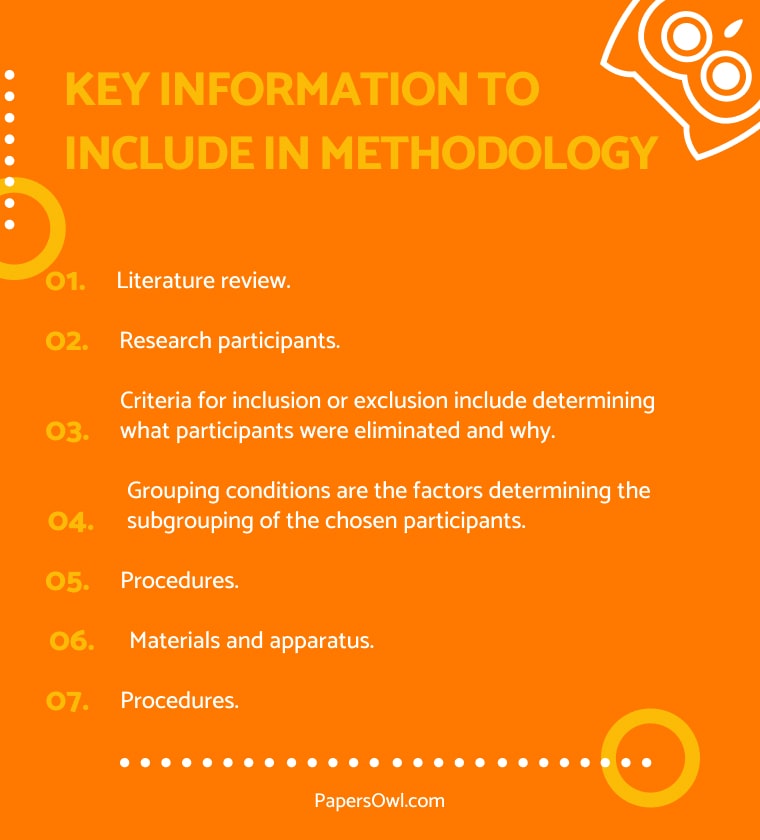A Scholar’s Guide to Writing the Methods Section of a Research Paper
Table of contents
- 1 What Is the Methods Section of a Research Paper?
- 2 Methodology vs. Methods
- 3 Structure of the Methodology in A Research Paper
- 4 7 Pieces of Advice on How to Write the Methods Section
- 5 Key Information to Include in Methodology
- 6 Helping Hand in Writing Methodology Chapter
- 7 FAQ
In the vast realm of academic writing, the research paper is a testament to a scholar’s systematic exploration of a particular subject. Each section of the paper plays a pivotal role, knitting together the fabric of the study. While the introduction sets the stage and the results showcase the findings, the methods section forms the backbone, providing a clear roadmap for any reader or researcher wishing to replicate or understand the study’s inner workings.
As pivotal as a research thesis, methods sections crafting an impeccable methods section often pose challenges for researchers. This article aims to elucidate the intricacies of constructing a robust Methodology section in a research paper.
After reading our guide, you will:
- Get a clear understanding of the importance and purpose of the Methods in a research paper.
- Discover in detail what a comprehensive Methods section should contain.
- Learn the essentials of writing a methodology in a research paper.
Now, let’s take a detailed look at these points!
What Is the Methods Section of a Research Paper?
Do you have any questions about how to write the Methodology? Firstly, let’s define this section for research.
The Methods or Methodology section of the research paper gives the road map for how the research was conducted. A well-crafted Methods section guides the researcher and helps other scholars understand and replicate your study. In other words, it’s like a recipe in a cookbook. If you want others to recreate your experiment or study, this section tells them exactly how you did it.
The Methodology should be thoughtfully planned, executed, and reported. The reader should understand the basic research structure and the steps taken to conduct the study, including the research design, data collection methods, and data analysis techniques.
The Methodology of a research study is essential for several reasons:
Validity and Reliability: A well-defined Methodology provides the foundation for the criteria and reliability of the study, particularly in addressing the research question for research. It helps to ensure that the research is conducted systematically and controlled and that the results are accurate and trustworthy.
Replicability: It allows other researchers to understand and replicate the study, which is important for building on existing knowledge and advancing the field.
Clarity and Transparency: A clear and concise section on methods helps readers understand the research process and evaluate the results. This increases transparency and builds trust in the findings.
Justification of Approach: The research methodology provides a rationale for the approach taken, including why certain methods and techniques were chosen and how they relate to the question for research.
Evidence of Rigor: A well-executed research methodology demonstrates the rigor and thoroughness of the study, which is important for establishing the credibility of the results.
Methodology vs. Methods
In rigorous academic and research contexts, there is a distinction between “methods” and “methodology.” However, there might be overlapping use outside of strict scholarly circles or in more informal discussions.
“Methods” generally refer to specific techniques or procedures, while “methodology definition” dives into the theoretical framework and rationale behind those techniques. Correctly using the terms is essential in formal academic and research writing to maintain clarity and precision.
Nevertheless, in many research papers, the specifics of the methods (the “how”) are the primary focus, and the theoretical rationale (the “why”) might be briefly touched upon within the same section.
Structure of the Methodology in A Research Paper
Most methods sections of a research paper are organized chronologically, starting with the initial steps (e.g., participant recruitment) and ending with the final steps (e.g., data analysis). Let’s take a look at the subsections that may appear in the research paper:
Research summary
The methodology section of a scientific paper typically begins with a concise summary of its contents and restates the research study’s particular method or successful research thesis.
In empirical social sciences research, the natural and physical sciences follow this with a detailed description of the participants or subjects involved, specifying their demographics, sample size estimation, and recruitment process. The chosen methods produce transparency in how the data sources exist and are utilized.
Scientific methods
Next, the study’s materials, equipment, or apparatus are outlined, with attention given to any specific methods or tools vital to reproducing the experiment. Whether in the natural sciences or social and behavioral sciences, it’s important to explain the unique specifications of these materials.
Step-by-step description
The procedural account, which describes how the study was conducted, is the central part of the effectively written methodology section.
This should include all relevant specific methodological procedures, such as tasks performed by participants or subjects and the sequence of operations.
Analyzing data
Following this, the section on analyzing data discusses how the gathered data was processed, describing any widely accepted rules or software employed. An ethics subsection is necessary if the research focuses on sensitive or ethical considerations, such as human or animal subjects. This part should outline how participant rights were protected, including confidentiality and informed consent.
The Project’s methodology complements
Finally, the project’s methodology complements the study’s limitations by addressing potential biases or specific theoretical perspectives that may have influenced the results. This section wraps up by recapping the methodology’s contribution to the study’s integrity and reproducibility, ensuring the reader understands the steps taken to answer the question of research.
Organize the research
The APA style suggests organizing the methodology into three subsections for journal-style scientific papers: participants, apparatus, and procedure. Additionally, it’s a best practice to include writing tips on preferred reporting items and writing tip statistical designs to ensure clarity and adherence to empirical, analytical group standards.
Participants
This segment reports the participants’ characteristics in the experiment, the sampling method, and the sample size.
Report the sample characteristics, sampling procedures, and sample size to begin the existing method section and provide a detailed overview of the study’s participant group.
Characteristics
In human research, it’s important to use terms like “participants,” “respondents,” or “subjects” (for non-human studies) to describe the individuals involved. All essential details regarding the participants’ demographics should be specified to offer a clear understanding of the population being studied. These characteristics may include:
- Age;
- Gender identity;
- Ethnic or racial group;
- Socioeconomic status;
- Education level;
- Any other relevant variables related to the questions of research.
✏️Example:
Fifty female undergraduate students between 19 and 23 participated in the experiment. All were sophomores in the Faculty of Engineering and native English speakers who lived on the university campus. The participants were separated into two groups of 25 students, each without determining criteria. This study was conducted at the University of Alabama, USA.
Sampling Strategy
The method used for recruiting participants is critical to the study’s credibility. Explain whether a random, stratified, or convenience sampling method was used. Additionally, report the sample size and any relevant practical limitations that impacted this number. You should also report the following:
- Selection mode;
- Was it voluntary;
- Were the participants assigned to the study?
- Additionally, the compensation provided to participants must be identified.
✏️Example:
The ethics board was petitioned, and approval was granted before the recruitment of participants commenced. All the female sophomores from the faculty of Engineering at the University of Alabama, USA, were invited to participate, and those who did were self-selected. In liaison with department heads, the students were offered additional credits in a faculty-wide course as compensation for their time.
Sample Size
In this subsection:
- Report the sample size for each group;
- The statistical power aimed for;
- The analyses used to determine these numbers.
Ensuring the study had adequate statistical power is critical to detecting an effect if one exists, aligning the research with widely accepted rules governing statistical analysis.
The calculations for the sample size should be based on:
- The desired effect size;
- Dependent variable;
- Independent variable.
In addition to calculating power, it’s important to mention any adjustments made due to gathering data methods or challenges during the data collection process. This should be noted if the final sample deviated from what was initially required due to unforeseen circumstances, such as participant dropout. The analysis should still provide insight into explained behaviors based on the available raw data.
✏️Example:
For this experiment to achieve 80% power to detect an effect of 10%, with a significance level of .05, 30 participants were required in each condition. The final sample size met these requirements, ensuring the study could generate objective knowledge based on the proposed methodology. This sample size allowed us to analyze the dependent variable effectively using the chosen method.
Apparatus
The Apparatus section details all materials, tools, and equipment used during the experiment or study. It is crucial to understand how data was collected and measured.
- Each apparatus should be described with specifics, including the following:
- Model number;
- Manufacturer;
- Any reliability and validity considerations.
For a thorough methodological approach, it’s essential to name the instruments and explain how they contribute to answering the research questions.
Primary and Secondary Measures
Begin by defining the primary and secondary outcome measures that will help address the research questions.
These may include:
- Hardware (such as physiological measurement devices);
- Software (like data analysis programs);
- Tools used to collect survey data or conduct observational studies.
Quality of Measurements
Ensuring the quality of measurements is critical in the methods section. For instance, researchers might undergo training to collect data more reliably, and pilot studies may be conducted to test the apparatus or instruments on a small sample before full deployment.
When using subjectively coded data (such as qualitative open-ended responses), report interrater reliability to indicate the consistency between evaluators. This helps to explain observed behaviors more accurately and ensures the data’s credibility.
This section provides detailed descriptions of the materials and instruments, establishing the foundation for analyzing existing data and supporting the transparency of the research study’s method.
✏️Example:
To measure academic anxiety in students, we used the Academic Anxiety Inventory (AAI; Pizzie & Kraemer, 2017), which consists of 50 Likert scale questions. The inventory’s subscales include math, science, and test anxiety. An example question is: “I feel anxious when preparing for exams.” The Cronbach’s alpha for the subscales exceeded .85, indicating high internal consistency. Additionally, a general knowledge test of 20 multiple-choice questions was developed to assess participants’ familiarity with basic concepts in science and humanities.
Procedure
In the Procedure section, thoroughly describe the conditions under which the experiment or study was conducted.
Include all basic procedures used to collect and analyze data, along with the instructions provided to participants. Clearly outline the research design and provide enough detail for another researcher to replicate the study.
Detailing the procedures used in your study clarifies how data was gathered, processed, and analyzed. This ensures that your study’s outcomes are rooted in well-defined methods and enhances the study’s credibility. It also makes it easier for future researchers to build on your findings.
✏️Example:
The two groups of participants were placed in two different classrooms at individual desks and given 10 minutes to answer the questions. They were instructed to give the first answers they thought of without thinking too deeply. Each group had a supervisor attached to it.
Writing a research paper requires a great deal of skill and knowledge, so if you need help compiling the Methods section of your paper, consider using a
professional coursework writing service to help you.
7 Pieces of Advice on How to Write the Methods Section
You already know the relevance of the Methods part to your research paper. Additionally, you must adhere to formatting guidelines specific to your field.
If you cannot write according to standards, you can use a
research paper writing service to get good results. Go for one with good systematic reviews and a super online reputation.
Here are some more tips for a concise and meticulously written Methodology:
- Method Introduction: Introduce the research methods used in the section on methodology. Provide a brief overview of the research design, data collection, and analysis techniques.
- Methodological Connection: Establish the connection between the methodology and the research query.
- Instrument Introduction: Introduce the instruments used to assemble data, such as surveys, interviews, or observation. Briefly describe each instrument and how it will be used in the study.
- Analysis Discussion: Discuss the analysis techniques used to analyze the data collected.
- Background Information: Provide background information about the methodology and the relevant literature.
- Sampling Process: Discuss the sampling process used in the study. Explain how the sample was selected, the criteria used, and how the samples taken were determined.
- Limitations: Researchers were required to discuss any research constraints in the past tense, such as limited sample sizes, issues with the data collection process, or issues with the analysis methods employed. They had to explain how these constraints might have affected the study’s findings and conclusions.
Methods and results should match
In the Methods section, the results obtained should be discussed based on the experimental procedures used. Explain the methodology behind the techniques used to acquire all the observations and results of the experiment in the right order. You can create a detailed flowchart or block flow diagram (BFD) to easily describe the complexities of the study and its procedures to the reader.
Preferred statistical method subsections
The statistical analysis subsection comes at the end of the Methods section. It includes thoroughly describing the analyzed data to arrive at the results and conclusion.
Here, you must indicate all the data variables, including:

The Style of the methodology
As mentioned, it aims to explain how and why the experiment was carried out so that readers can understand it and possibly repeat the procedure.
Therefore, it is essential to be aware of your audience so you can modify your writing based on what they know and explain technical terms where necessary. If you find writing in the appropriate style difficult, you can
buy a research paper written by writers. You can find these writers on several platforms for college essays.
The methodology should read as though you describe the experiment to your reader.
For this reason, it should be worded in third-person constructs and a passive voice.
✏️Example:
You should use “We carried out a survey” and not “I carried out a survey.”
Key Information to Include in Methodology
Now you know what the Methods section is, what information must be included in this segment of your paper?
Here’s a summary of the things you need to include:

Helping Hand in Writing Methodology Chapter
It can be challenging for researchers to adequately describe their study methodologies and strategies when writing the methodology chapter of a research report.
To overcome the challenges, researchers can consider seeking peer feedback, utilizing a
PapersOwl or editor, and thoroughly reviewing and revising their methodology chapter multiple times.
With the help of an essay writing service, you can ensure that your research paper is accurate and successful.







